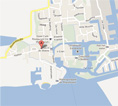New feature in WinGPS 6-2025:
Route planning 2.0 with obstructions
Stentec 7 Jan 2025
WinGPS 6 Pro, Voyager and Inland will receive a valuable new function for planning routes and sailing along the European route network. With the 2025 edition, closures and changed operating times from the shipping messages (FTM, or Fairway Traffic Message) will be taken into account. Due to an increasing number of maintenance activities and collisions with bridges and locks, this is more relevant than ever.
|
|
What is this new feature?
Without this new option, shipping reports had to be checked manually and routes had to be adjusted if necessary. Now WinGPS can do this automatically, depending on your entered ship properties, such as mast height. This saves you time and prevents unnecessary delays.
|
|
Practical examples: Uitwellingerga
When planning a route through the Uitwellingergabrug, the height of your ship is automatically taken into account:
Without the FTM obstructions option, the route is drawn for each mast height through the 7.2-metre high Uitwellingerga bridge. With the FTM obstructions option, at Edit route/Route settings/Planner, the route is dependent on the mast height.
Ships lower than 7.2m, including clearance, can pass under the bridge in Uitwellingerga. Higher ships up to a height of 11.2m are diverted over the Langweerderwielen under the 11.1m high bridge in the A7. Higher ships are diverted via IJlst through Sneek.
WinGPS 2025 calculates this automatically, as can be seen in the screenshots below.
Click on the screenshots to view them in a larger format
|
|

|
|
WinGPS 6 Pro 2025 without FMT obstructions H=8.2m
|
|

|
|
WinGPS 6 Pro 2025 with FMT obstructions Uitwellingerga H=8,2m
|
|

|
|
WinGPS 6 Pro 2025 with FMT obstructions Uitwellingerga H=12,2m
|
|

|
|
WinGPS 6 Pro 2025 with FMT obstructions Uitwellingerga H=6,2m
|
|
Practical examples: Groningen
For routes through Groningen there are situations where the fastest and shortest routes may differ, depending on the operation of bridges:
This route is the same without and with FMT closures. There are no closures now but there are unserviced bridges around the city, as shown by the shortest route without obstructions option. See the screenshots below for the difference between the fastest and shortest route. The mast height is 12.2m in both cases.
Click on the screenshots to view them in a larger format
|
|

|
|
WinGPS 6 Pro 2025 fastest route FMT obstructions Groningen H=12,2m
|
|

|
|
WinGPS 6 Pro 2025 shortest route FMT obstructions Groningen H=12,2m
|
|
Tips for use
When entering the mast height in the ship properties, we recommend taking into account a few decimetres of tolerance. This prevents surprises due to wind, waves or deviations in bridge constructions. You can first perform the calculations without tolerance and then add a few decimetres for extra certainty.
Please note: Tidal bridges, such as the Erasmus Bridge, are calculated by default with a tolerance of 1 metre at average low water. A dynamic correction of clearance heights based on wind and tide (with the Stentec Tidal ZUNO model) is on the wish list for future updates.
The sources used for this data are Rijkswaterstaat and EURIS. We recommend that you use the data from Rijkswaterstaat for routes in the Netherlands.
|
|
|
Why is this interesting to you?
The new Route Plans 2.0 function saves you time and prevents unnecessary frustration during your cruise. By automatically taking into account closures and bridge operating times, you always sail the most efficient and safe route. This not only makes your cruise more pleasant, but also more reliable, so you can fully focus on enjoying your journey.
|
|
|
|
|

















